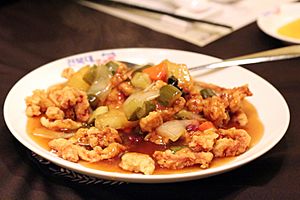Tangsuyuk facts for kids
 |
|
| Place of origin | China (original) Korea (introduced) |
|---|---|
| Region or state | Incheon Chinatown |
| Associated national cuisine | Korean Chinese cuisine |
| Created by | Chinese immigrants in Korea |
| Serving temperature | Warm |
| Main ingredients | Pork or beef loin, sweet and sour sauce |
| Korean name | |
| Hangul | |
|---|---|
| Hanja | |
| Revised Romanization | tangsuyuk |
| McCune–Reischauer | t'angsuyuk |
| IPA | [tʰaŋ.su.juk̚] |
Tangsuyuk (Korean: 탕수육; Hanja: 糖醋肉) is a yummy Korean Chinese dish. It features crispy meat covered in a sweet and sour sauce. You can make it with either pork or beef. It's a very popular dish in Korea!
Contents
The Story Behind Tangsuyuk
Where Did Tangsuyuk Come From?
Tangsuyuk was first created by Chinese merchants. They lived in the port city of Incheon, Korea. Many Chinese people still live there today. This dish came from a Chinese dish called tángcùròu. Most Chinese immigrants in Korea came from the Shandong region of China.
What Does the Name Mean?
The name Tangsuyuk is a mix of Chinese and Korean words. The first part, tangsu, comes from the Chinese words for "sugar" and "vinegar." The second part, yuk, is a Korean word that means "meat." So, the name basically means "sweet and sour meat." It's a perfect name for this delicious dish!
How Tangsuyuk Is Made
Making the Crispy Meat
To make Tangsuyuk, small pieces of pork or beef are used. They are covered in a special batter. This batter is usually made from potato or sweet potato starch. Sometimes, sticky rice flour is also added. The meat is then fried not once, but twice! This makes it extra crispy and delicious.
Creating the Sweet and Sour Sauce
The sauce for Tangsuyuk is sweet and tangy. It's made by boiling vinegar, sugar, and water together. Many different fruits and vegetables are often added to the sauce. These can include carrots, cucumbers, onions, pineapple, and even wood ear mushrooms. A little bit of starch is used to make the sauce thick and shiny.
Images for kids
-
Beoseot-tangsuyuk is a vegetarian version of the dish. It uses shiitake mushrooms instead of meat.


